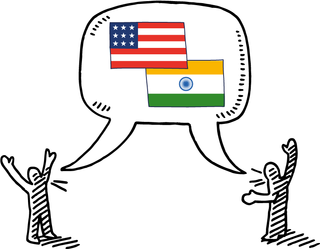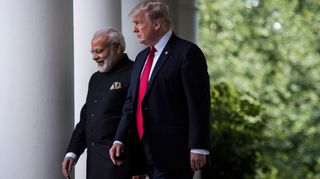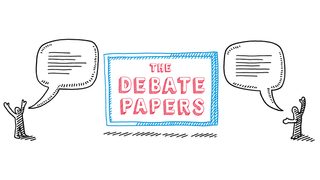"The Debate Papers" provides a platform for learned voices to argue issues affecting the United States and Australia. These counterpoints traverse topics such as economics, foreign policy and politics. If you’d like to contribute to the series, email brendan.thomas-noone@sydney.edu.au or jared.mondschein@sydney.edu.au.
India is courting peril by aligning militarily with the United States
Bharat Karnad
The nixing of the Iran nuclear deal, the Trans-Pacific Partnership, and the Paris Agreement are only some of the many ways that the United States has alienated its closest allies.1 President Donald Trump has already roiled the milieu by demanding that allies do more for themselves and rely less on his country.2 The United States, an inconsistent and unreliable friend even under prior US administrations, has increasingly become a feeble and feckless ally. Increasing military alignment, let alone a strategic partnership, with the United States would be a liability for India.
The dangers of partnering with the United States have only grown during the Trump administration. Trump’s decision-making method is, according to one former US intelligence official, based “less on fact and evidence and more on feeling, preference, emotion, grievance, tribe, loyalty”.3 Trump’s belief system sees the United States being “ripped off” in multilateral forums and that better terms are only obtainable on a bilateral basis. His world view is that of an economically-strapped and exploited America, its wealth decanted through unfair trade transactions and military pacts requiring the United States to expend its resources while allies strengthen their economies and free-ride on security. How can India expect to benefit from aligning itself with such a destabilising commander-in-chief?
India is no exception to Trump’s wrath
Indian Prime Minister Narendra Modi has been no exception to Trump’s scant respect for allied leaders, negligible interest in addressing what allied leaders want, and unreasonable expectations of loyalty.4 While Trump reciprocated the Indian leader’s trademark public hugs during Modi’s June 2017 Washington visit and made the usual noises about shared democratic values, Trump soon thereafter stuck it to India.5 Despite Modi’s fervent appeals, the Trump administration weakened India’s flagship US$167 billion information technology industry by all but killing off H1B visas — a generally tech-focused visa, of which some 70 per cent go to Indians.6 Furthermore, the United States has imposed tariffs on Indian steel, aluminium and engineering goods, accused India’s cost-competitive pharmaceutical industry of price-fixing, and challenged the Indian government’s agricultural subsidy scheme at the World Trade Organization.7 These measures reflect an attitude that is not just unsympathetic to Indian concerns but inimical to India’s national interest.

Weak on China and indifferent to Indian security
The basic geostrategic reason for India and the United States getting together is ostensibly to balance China’s power in Asia. As a candidate, Trump promised that he’d label China a “currency manipulator”, put Beijing under economic pressure, and join Asian states and Australia in arresting the spread of Chinese power and influence in the Indo-Pacific region. As president, however, he seems eager to humour Chinese President Xi Jinping and, far from penalising China, has reversed the technology ban on the Chinese telecommunications giant ZTE, tweeting that this would have cost “too many jobs in China” — the sort of solicitousness not shown towards India.8
With Washington spurning the hard line with China, it will likely flinch in military crises involving its Asian partners and the People’s Liberation Army.9 In this regard, Trump virtually urged Japan to get its own nuclear weapons.10 He has not, however, encouraged India to resume nuclear testing (barred by the 2008 Indo-US civilian nuclear cooperation deal) and secure for itself a proven thermonuclear arsenal (because the fusion device tested in 1998 had fizzled) even though it would be an Asian deterrent to China’s aggression, and lessen the military dilemma for the United States.11
Indeed, the nuclear deal is only the latest diplomatic contrivance in a series of US nonproliferation policies and actions from the early 1960s when the Indian nuclear energy program reached the weapons threshold. The US aim thereafter was to prevent India from obtaining nuclear weapons and, post-1998, proven thermonuclear armaments and intercontinental ballistic missiles.12 Given that its extended deterrence policy lacks credibility, Washington’s continued antipathy to India emerging as a thermonuclear weapons-armed Asian military counterweight suggests an absence of trust and Washington’s desire to keep India from becoming an independent power.
Few dividends for India from US alignment
Trust is the glue binding strategic partnerships. Its absence ensures that geopolitical plans remain only intentions. A trust deficit has always marred Indo-US relations, with Washington continually disregarding contractual obligations, retroactively changing agreements, and imposing economic and technology sanctions that have hurt India’s growth prospects and disabled its fighting capabilities.13
A trust deficit has always marred Indo-US relations, with Washington continually disregarding contractual obligations, retroactively changing agreements, and imposing economic and technology sanctions that have hurt India’s growth prospects and disabled its fighting capabilities.
Post-nuclear deal, the United States has not walked the talk, even denying India high technology already accessed by China.14 The US-Indian Defence Technology and Trade Initiative, created in 2012 to help increase defence ties between the two nations, has yet to produce any collaborative projects in advanced military technology. Yet India is nonetheless still asked to seed trust by buying more high-cost, non-lethal goods (transport and P-8I maritime surveillance aircraft) and obsolete weapons systems — F-16 combat aircraft, M-777 howitzers, etc.15
Finding support outside of the United States
Juxtaposed with Moscow’s supply of frontline weapons systems (Sukhoi Su-30MKI fighter planes, T-90 tanks, and leasing of the nuclear-powered Akula-II-class SSNs) and assistance to sensitive indigenous projects like the nuclear-powered ballistic missile-firing Arihant-class submarine, and America ends up looking less like a friend than a proto-adversary intent on keeping India down.
It is an impression reinforced by the US Congress denying India the waiver from sanctions under Countering America’s Adversaries Through Sanctions Act (CAATSA) targeting Russia and sought by Defense Secretary James Mattis.16 CAATSA will seriously hurt the Indian military considering 70 per cent of its equipment is of Russian origin. The twist here lies in the hint by some in US policy circles that CAATSA’s impact would be especially mitigated if India followed up the Logistics Support Agreement by signing the Communications Compatibility and Security Agreement (COMCASA).17 But COMCASA, the Indian armed forces fear, will permit the United States to penetrate – vertically and horizontally – the official communications network, including the country’s strategic forces’ command and control links, which is an unacceptable outcome.18
Far from getting Delhi to thin its ties with Russia, CAATSA led Modi to a mini-summit with President Vladimir Putin on 21 May 2018. There, Indo-Russian ties were upgraded to, in Foreign Minister Sergei Lavrov’s words, a “special privileged strategic partnership”.19 Maybe the Indian government is waking up to the unpleasant reality that it is more onerous to have America as a friend than foe, because an adversary at least knows where it stands with Washington.

India should increase military alignment with the United States
Sumona Guha
As a rising power and the fastest-growing major economy in the world, India clearly wants to enhance its influence on the world stage. Prime Minister Modi has raised India’s profile on several key global issues while actively courting foreign investment to help meet India’s economic goals. Given these trendlines, India should increase its military alignment with the United States. Indeed, it is already doing so. Pursuing deeper military ties with the United States would help India meet many goals as it stakes out a global leadership role.
Already strong US-India defence ties
India's defence purchases from the United States have been rising for about a decade, beginning under the previous Indian government led by PM Manmohan Singh. Though Russia remains India’s primary defence supplier, India’s arms imports from the United States have grown dramatically in recent years. Since 2008, India-US defence trade has grown from about US$1 billion to US$15 billion, putting the United States in second place behind Russia.20 As the relationship develops, India can expect to gain increasing access to unique systems and platforms that only the United States can offer.
Leaders in both India and the United States point to the strategic value of closer military alignment given that both countries are grappling with the rise of China.
In addition to arms sales, Washington and New Delhi are taking significant steps to deepen and regularise defence cooperation. In 2016, after 10 years of negotiations through a number of Indian and US administrations, the two countries signed a Logistics Exchange Memorandum of Agreement (LEMOA) to allow their militaries to increase the ease and frequency of security-related exchanges and cooperation. Other foundational agreements under consideration include the Communications Compatibility and Security Agreement (COMCASA) and the Basic Exchange and Cooperation Agreement (BECA). These agreements do not place additional obligations on India or the United States but provide mechanisms to share logistical supplies and security-related information.21
Leaders in both India and the United States point to the strategic value of closer military alignment given that both countries are grappling with the rise of China. America’s ability to project power deep into Asia offers India a potentially crucial partner as it seeks to defend its interests in the region. The United States has prioritised a stronger defence partnership with India, designating India as a “major defense partner”.22 Proponents of a stronger US-India partnership view India as a “net security provider in the Indian Ocean region”.23 As another sign of growing strategic alignment, the US and Indian foreign ministers and defence ministers will meet jointly this year.24
India needs help addressing regional threats
Successive Indian leaders have cited the danger of India’s neighbourhood, including threats from Pakistan on its western flank and threats from China, with whom India shares a 3,400-kilometre land border where skirmishes flare up, most recently in 2017.25 India is also increasingly concerned about terrorist threats. As such, India is developing its counter-terrorism and conventional capabilities to manage both existing and emerging threats. While India remains sceptical of the US-Pakistan relationship, in recent years India and the United States have augmented their counter-terrorism relationship with discussions about enhancing information sharing on terrorism. In addition to training enhancing capabilities, US military procurements provide top quality platforms and products to help India increase its own capabilities against regional threats.
India is embracing its role as a global leader, away from non-alignment
In recent years, India has increasingly moved away from its traditional framework of non-alignment, through which it maintained strategic autonomy since its independence in 1947. Today, India is an important rising power not only in Asia but on certain global issues as well. It is the fastest growing major economy in the world with World Bank estimates of 7.1 per cent GDP growth in 2016,26 and its population is expected to surpass China’s by 2025.27 Since coming to power in 2014, Prime Minister Modi has revitalised India’s foreign policy and has spoken regularly about India’s desire to be a leading, not a balancing power. On issues ranging from humanitarian assistance and disaster relief to diplomatic statements on China’s activities in the South China Sea, India is demonstrating a more assertive foreign policy to advance its interests on global issues.
India's rising global leadership has become visible in a number of areas. For example, India recently adopted a multi-stakeholder approach to internet governance. Delhi has also staked out a strong position on climate change while Prime Minister Modi recently launched an International Solar Alliance with French President Emmanuel Macron.
Since coming to power in 2014, Prime Minister Modi has revitalised India’s foreign policy and has spoken regularly about India’s desire to be a leading, not a balancing power.
More broadly, India, like other countries in Asia, is dealing with a rising China. While India does not today compare to China economically, the size of India’s population and territory makes it a key player in Asia. Competition between India and China — ranging from economic to security realms — seems almost inevitable, especially given historic tensions.
While India has traditionally shied away from any actions that could be seen by China as confrontational, it has recently taken some principled stances that, while couched in global norms and expectations, signal a new willingness to stand up to Beijing. The first such stance was India’s 2016 statement of support for the Hague Tribunal’s decision that rejected China’s claims in the South China Sea.28 India’s strong statement was seen as a sign of commitment to international law. The second was India’s unwillingness to participate in China’s Belt and Road Initiative Summit in 201729 and clear position that international infrastructure investment should include environmental protections, transparency, and respect for sovereignty and territorial integrity.30
Deeper US defence ties help India become a hub for defence manufacturing
As part of Prime Minister Modi’s Make in India initiative,31 foreign companies that manufacture in India need to meet certain domestic content requirements, usually 30 per cent. This requirement reflects India’s desire to pair foreign direct investment with skills and technology transfers. In the defence arena, major US companies have announced plans to manufacture in India. For example, Lockheed Martin is considering moving its entire production line of F-16s to India.32 These types of investments result in significant transfers of skills and technology, and lead to job creation in India — an imperative for India. If India succeeds in providing enough incentives for major US defence companies to transfer technologies and production expertise to India, it will help India meet its goal of producing high quality defence exports for the region.
India already supports the US Indo-Pacific strategy
The leaders of the United States, India and Japan have spoken of new forms of cooperation in the Indo-Pacific region, including on infrastructure investment, while Australia has engaged with these three countries in the Quadrilateral format. The United States is looking for partners to uphold principles of freedom of navigation across the Indo-Pacific and India — as well as Japan and Australia — are well situated to do so. Stronger military alignment with the United States — as well as these other countries — would position India to work with a range of international partners on humanitarian assistance and disaster relief, the promotion of maritime domain awareness, and the protection of sea lanes of communication.
Keeping expectations realistic
While India has much to gain from deepening military alignment with the United States, this does not suggest the two countries will or should enter in to a formal military alliance. India and the United States share many common interests and could benefit from a stronger military partnership, but there are also clear differences in outlook, and India’s desire to maintain strategic autonomy development will preclude a formal alliance of the type that the United States has built with other powers like Japan or Australia. Nevertheless, the United States has built meaningful partnerships with many other countries across the region and beyond, and there is a good deal still to be harvested from a closer defence relationship with India. Closer military alignment would allow India and the United States to advance strategic objectives in Asia.







